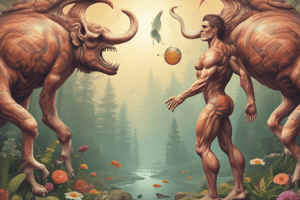Podcast
Questions and Answers
What describes the process by which species split into two or more species over time?
What describes the process by which species split into two or more species over time?
- Natural selection
- Speciation (correct)
- Artificial selection
- Microevolution
Which of the following concepts emphasizes that evolutionary changes occur slowly over long periods?
Which of the following concepts emphasizes that evolutionary changes occur slowly over long periods?
- Gradualism (correct)
- Microevolution
- Perpetual change
- Natural selection
What is one fundamental difference between natural and artificial selection?
What is one fundamental difference between natural and artificial selection?
- Natural selection is faster than artificial selection.
- Natural selection requires the use of specific mating techniques.
- Artificial selection leads to more genetic diversity.
- Natural selection occurs without human intervention. (correct)
Which scientific field was not developed until after Darwin's time and was not considered in his theories?
Which scientific field was not developed until after Darwin's time and was not considered in his theories?
What type of evolution refers to large scale evolutionary changes over time?
What type of evolution refers to large scale evolutionary changes over time?
What is PCR primarily used for in medical diagnostics?
What is PCR primarily used for in medical diagnostics?
Which of the following is NOT a function of PCR?
Which of the following is NOT a function of PCR?
What is the role of PCR in the field of biotechnology?
What is the role of PCR in the field of biotechnology?
How does PCR assist in environmental science?
How does PCR assist in environmental science?
What does pharmacogenomics study in relation to PCR?
What does pharmacogenomics study in relation to PCR?
What distinguishes homologous traits from analogous traits?
What distinguishes homologous traits from analogous traits?
Which of the following best exemplifies convergent evolution?
Which of the following best exemplifies convergent evolution?
Which statement reflects Lamarck's theory of evolution?
Which statement reflects Lamarck's theory of evolution?
What does the principle of uniformitarianism suggest about Earth's features?
What does the principle of uniformitarianism suggest about Earth's features?
According to Darwin's theory of natural selection, what primarily drives the evolution of species?
According to Darwin's theory of natural selection, what primarily drives the evolution of species?
Which concept involves species evolving in different directions from a common ancestor?
Which concept involves species evolving in different directions from a common ancestor?
What does catastrophism propose about the formation of Earth's geological features?
What does catastrophism propose about the formation of Earth's geological features?
What is a key idea in Darwin’s concept of common ancestry?
What is a key idea in Darwin’s concept of common ancestry?
Which of the following traits is considered analogous?
Which of the following traits is considered analogous?
Which statement best represents the concept of natural selection?
Which statement best represents the concept of natural selection?
Study Notes
Differences in Traits
- Homologous traits are inherited from a common ancestor and may serve different functions, e.g., human arm vs. bat wing.
- Analogous traits serve similar functions but do not share a common ancestor, such as butterfly and bird wings.
Evolution Types
- Convergent evolution leads unrelated species to develop similar traits due to environmental pressures, e.g., dolphin and shark body shapes.
- Divergent evolution occurs when species evolve in different directions from a common ancestor, exemplified by Darwin’s finches with varying beak shapes.
Lamarck's Theory
- Lamarck theorized organisms could pass on acquired traits; giraffes supposedly inherited long necks from ancestors that stretched their necks.
Geological Principles
- Uniformitarianism posits that Earth's features developed through ongoing processes like erosion and sedimentation.
- Catastrophism suggests Earth's features were shaped by sudden violent events like earthquakes and floods.
Darwin's Insights
- Natural Selection describes evolution via advantageous traits becoming common through survival and reproduction.
- Common ancestry implies all species descended from shared ancestors, diverging over time to create biodiversity.
Darwin's Concepts
- Perpetual Change indicates the world is constantly evolving, as recorded in the fossil record.
- Multiplication of Species refers to species splitting into more species over time, driving biodiversity through speciation.
- Gradualism suggests evolutionary changes occur slowly over long periods, opposing the idea of sudden large-scale changes.
Selection Processes
- Natural Selection occurs without human intervention, driven by environmental pressures.
- Artificial Selection involves human-led breeding for desired traits, such as in dog breeding or crop selection.
Aspects Not Addressed by Darwin
- Genetics and the mechanisms of inheritance weren't understood during Darwin's time; DNA discovery came later.
- Epigenetics explores gene expression changes without altering genetic code, influenced by environmental factors.
Types of Evolution
- Microevolution involves small gene frequency changes within a population over time.
- Macroevolution addresses large-scale changes in gene frequencies that can determine new species.
PCR Applications
- Medical Diagnostics: PCR detects pathogens in clinical samples, crucial for diagnosing diseases like COVID-19, HIV, and TB.
- Genetic Research: Identifies genetic alterations related to disorders such as cystic fibrosis and sickle cell anemia.
- Forensic Science: PCR aids in DNA profiling for suspect identification and paternity testing through DNA comparison.
- Biotechnology: Utilized for gene cloning, genetic engineering, and sequencing DNA for research purposes.
- Environmental Science: Detects microorganisms in samples and studies genetic diversity in ecosystems.
- Agriculture: Identifies genetically modified organisms in food based on pathogen detection.
- Personalized Medicine: Pharmacogenomics uses PCR to tailor treatments based on genetic variations affecting drug responses.
Studying That Suits You
Use AI to generate personalized quizzes and flashcards to suit your learning preferences.
Description
This quiz explores key concepts related to evolution, including speciation, natural versus artificial selection, and the scale of evolutionary changes. It also touches on the advancements in genetics that emerged after Darwin's time, including techniques like PCR. Test your understanding of these fundamental biological principles.




